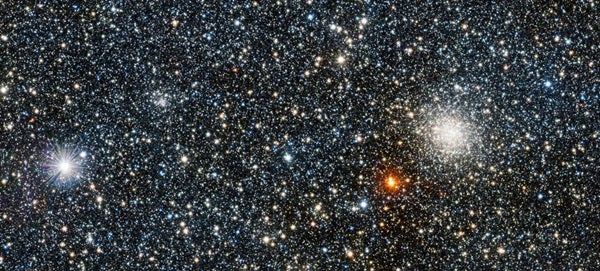The dazzling globular cluster called UKS 1 dominates the right-hand side of the image from ESO’s VISTA survey telescope at the Paranal Observatory in Chile. But if you can drag your gaze away, there is a surprise lurking in this rich star field — a fainter globular cluster that was discovered in the data from one of VISTA’s surveys. You will have to look closely to see the other star cluster, which is called VVV CL001 — it is a small collection of stars in the left half of the image.
But VVV CL001 is just the first of VISTA’s globular discoveries. The same team has found a second object, dubbed VVV CL002. This small and faint grouping may also be the globular cluster that is the closest known to the center of the Milky Way. The discovery of a new globular cluster in our Milky Way is rare. The last one was discovered in 2010, and only 158 globular clusters were known in our galaxy before the new discoveries.
These new clusters are early discoveries from the VVV survey that is systematically studying the central parts of the Milky Way in infrared light. Dante Minniti leads the VVV team from the Pontifica University of Chile and Philip Lucas from the University of Hertfordshire, United Kingdom.
As well as globular clusters, VISTA is finding many open, or galactic, clusters, which generally contain fewer, younger stars than globular clusters and are far more common. Another newly announced cluster, VVV CL003, seems to be an open cluster that lies in the direction of the heart of the Milky Way, but much further away, about 15,000 light-years beyond the center. This is the first such cluster to be discovered on the far side of the Milky Way.
Given the faintness of the newly found clusters, it is no wonder that they have remained hidden for so long; up until a few years ago, UKS 1, which easily outshines the newcomers, was actually the dimmest known globular cluster in the Milky Way. Because of the absorption and reddening of starlight by interstellar dust, these objects can only be seen in infrared light and VISTA, the world’s largest survey telescope that is ideally suited to searching for new clusters hidden behind dust in the central parts of the Milky Way.
One intriguing possibility is that VVV CL001 is gravitationally bound to UKS 1, making these two stellar groups the Milky Way’s first binary globular cluster pair. But this could just be a line-of-sight effect with the clusters actually separated by a vast distance.
The dazzling globular cluster called UKS 1 dominates the right-hand side of the image from ESO’s VISTA survey telescope at the Paranal Observatory in Chile. But if you can drag your gaze away, there is a surprise lurking in this rich star field — a fainter globular cluster that was discovered in the data from one of VISTA’s surveys. You will have to look closely to see the other star cluster, which is called VVV CL001 — it is a small collection of stars in the left half of the image.
But VVV CL001 is just the first of VISTA’s globular discoveries. The same team has found a second object, dubbed VVV CL002. This small and faint grouping may also be the globular cluster that is the closest known to the center of the Milky Way. The discovery of a new globular cluster in our Milky Way is rare. The last one was discovered in 2010, and only 158 globular clusters were known in our galaxy before the new discoveries.
These new clusters are early discoveries from the VVV survey that is systematically studying the central parts of the Milky Way in infrared light. Dante Minniti leads the VVV team from the Pontifica University of Chile and Philip Lucas from the University of Hertfordshire, United Kingdom.
As well as globular clusters, VISTA is finding many open, or galactic, clusters, which generally contain fewer, younger stars than globular clusters and are far more common. Another newly announced cluster, VVV CL003, seems to be an open cluster that lies in the direction of the heart of the Milky Way, but much further away, about 15,000 light-years beyond the center. This is the first such cluster to be discovered on the far side of the Milky Way.
Given the faintness of the newly found clusters, it is no wonder that they have remained hidden for so long; up until a few years ago, UKS 1, which easily outshines the newcomers, was actually the dimmest known globular cluster in the Milky Way. Because of the absorption and reddening of starlight by interstellar dust, these objects can only be seen in infrared light and VISTA, the world’s largest survey telescope that is ideally suited to searching for new clusters hidden behind dust in the central parts of the Milky Way.
One intriguing possibility is that VVV CL001 is gravitationally bound to UKS 1, making these two stellar groups the Milky Way’s first binary globular cluster pair. But this could just be a line-of-sight effect with the clusters actually separated by a vast distance.










